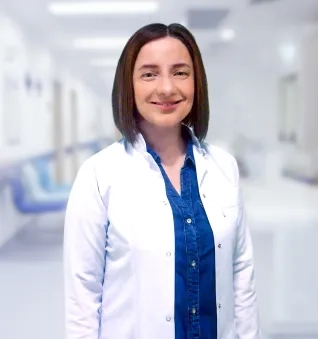Alo Yeditepe
Alo Yeditepe
Migraine and Its Treatment
Migraine is a very common neurological disease with headache attacks. A person with a migraine has moderate to severe headache attacks. And these attacks can lead to serious deterioration in the quality of life. Yeditepe University Kozyatağı Hospital Neurology Specialist Assoc. Prof. Dr. Emin Özcan answered the questions about migraine and its treatment.
Is migraine an inherited disease?
Although there is no clear transition from mother to child or father to child, such as known genetic diseases, the risk of migraine is increased in those who have migraine in the first degree. Genetic transition is in question. It would be more accurate to say that the risk increases here.
Why do people have migraine?
In individuals genetically predisposed to migraine disease, some factors trigger, such as bad and smells, wind. With a triggering factor, as a result of the increase of some signals and some hormones in the brain, enlargement of the vessels occurs and accordingly, pains occur. Hence, not everyone has migraines. The important thing here is that genetically predisposed people are exposed to trigger factors. As a result, migraine attacks are triggered and the disease occurs.
How to treat migraine?
Migraine treatment has three main steps. One of them is lifestyle changes. If there are lifestyle problems that increase migraine attacks, the factors that trigger them should be determined and must be removed from our lives. The second is to eliminate the pain that seriously deteriorates the quality of life during the attack, that is, during the pain, leading to loss of labor, as soon as possible and to try to ensure that it does not experience again. Thirdly, if the frequency of attacks is too high, it is to prevent or reduce the number of these attacks. Therefore, there is a three-step approach to the treatment of migraine.
If left untreated, can mild migraine lead to more severe pain?
Actually, that is not possible. In other words, it is not possible to say that if we do not treat mild attacks, they will lead to a worse situation. The disease has a nature, a course. Some factors worsen and improve this course.
In other words, if mild attacks are not treated, they will not lead to severe attacks. If there are worsening factors, failure to eliminate them may lead to a worsening of attacks and an increase in frequency.
The crucial thing here is to eliminate the factors that increase the frequency of attacks. If the condition becomes severe, different medications or migraine vaccines may be used.
Are there any characteristics that distinguish migraine pain from other headaches?
Yes, there are. Migraine pain typically settles unilaterally. There may be a double-sided settlement, but it is generally one-sided. It is a throbbing pain. Sometimes it may be accompanied by nausea and vomiting. It also has light sensitivity. While normal light does not normally disturb us, during pain, that light can disturb us. This is called photophobia.
In addition, sounds that do not normally bother us may become uncomfortable during pain. This is called phonophobia. Again, migraine pain can increase with walking, and moving the head. Because of this headache, patients want to lie in a quiet, calm, dark place without moving at all.
In addition, one of the most important characteristics of migraine pain is its duration. If left untreated, it typically takes longer than four hours. The maximum duration is seventy-two hours. We do not expect it to take more than three days.
We can summarize the characteristic of migraine headaches in the form of throbbing, unilateral headaches lasting at least 4 hours and up to seventy-two hours, accompanied by nausea and vomiting, sensitivity to light and sound, and increased headaches with walking.
How to diagnose migraine?
The diagnosis of migraine is mainly made by the clinic, that is, by the evaluation of the character of the headache described by the patient by an experienced neurologist. There is no special laboratory finding of migraine or brain imaging. We want the MRI we want to diagnose migraine in a patient with migraine pain to exclude any other brain-related pathologies that may be migraine-like and lead to headaches. Again, we would like to evaluate whether there are additional diseases that can worsen pain such as anemia, thyroid disorders, and B12 deficiencies in laboratory tests. Therefore, the diagnosis of migraine is made clinically by evaluating the complaints of the patient by an experienced neurologist.
In which age group is migraine more common, is there a difference between men and women?
Migraines tend to be more common between the ages of thirty and forty. Again, there is a much higher incidence of women than men.
What is a migraine vaccine?
Migraine vaccinations are a type of treatment that leads to less pain or complete disappearance of attacks in patients with frequent pain attacks, not to relieve migraine attacks. Monoclonal antibody leads to inhibitions in the pathophysiology of migraine, some intracranial signaling pathways that occur in the formation of migraine disease. These are newly developed drugs that prevent pain attacks by causing this inhibition. It is administered as a subcutaneous injection. In other words, it is a form of an injection that the person can apply on his/her own, not intramuscular use, but into the arm, abdomen, and upper leg area.
Is it a vaccine injected in the arm or the form of a needle?
After the appropriate medical training is given to the patients, the patients apply the injection on their own without seeing the needle. In the form of subcutaneous injection, it is applied to the arm, abdomen, and upper leg area.
How long has the migraine vaccine been used in our country?
The migraine vaccine was licensed about a year and a half ago and is still widely used in our country.
Is it applied to every patient on request? Or are there certain criteria?
It is not applied to every patient on request. We use it in patients who do not respond to classic migraine treatments.
First of all, we try to treat the patient with classical methods. We prefer these in patients who cannot get a response with classical methods or who cannot use these methods due to side effects.
Apart from this, we do not apply migraine vaccines to every patient who says, "I want to be vaccinated against migraine".
Are migraines vaccinated in public hospitals or private hospitals?
Migraine vaccination can be applied in any medical institution. Unfortunately, the social security institution is not paying back this medicine. It has to be paid for by the patient. It can also be applied without distinguishing between private hospitals and public hospitals.
What is the average cost of this medication?
Its price changes every day because of the differences in the exchange rate. Therefore, it is not possible to say an exact price at the moment. You can find out more about this by asking your pharmacist.
Does the migraine vaccine provide a permanent solution?
Unfortunately, vaccination is not a permanent solution. Thus, the migraine does not go away completely because you are vaccinated. Our main goal when administering this vaccine is to reduce or eliminate migraine attacks. Make sure that they are mild, not severe. Therefore, it is possible to say that it causes the symptoms to pass mildly and the number of migraine attacks to decrease or disappear. However, it is not a permanent solution that can completely eliminate the disease. It reduces migraine attacks and makes the symptoms milder.
How does the migraine vaccine protect against attacks?
The vaccine has been shown in various studies to reduce the frequency of attacks by sixty to seventy percent after an effective, appropriate treatment course, and to cause the symptoms of incoming attacks, that is, the course of attacks, to be mild In other words, there is a significant decrease and disappearance in post-vaccine attacks. The frequency of attacks may increase again over time. If this happens, six months of treatment can be reapplied.
How often is the migraine vaccine administered? What are the side effects?
After a maximum tolerable dose, there is a three-month treatment. You need to get vaccinated every month. At the end of these three months, there may be serious improvements. However, if there is no clear response, an additional extension of three months can be made.
After a six-month treatment protocol, that is, loading dose, we can achieve serious protection against migraine attacks at the end of injection treatment vaccination every month. In these various studies, it has been shown at different rates, but it has been shown that sixty to seventy percent of migraine attacks are prevented and attacks are mild.
There may be side effects such as pain and soreness at the injection site. This is among the most frequently reported side effects. Again, mild malaise and fatigue can cause mild upper respiratory tract infection. Constipation can also be seen. In general, these are not seen to prevent vaccination. So, it would be more accurate to say that there are manageable side effects. Studies show that patients also have very low rates of not continuing vaccination due to side effects that may occur.
What helps or triggers migraine pain?
One of the things that are good for migraine pain is to be in a quiet, calm, dark environment with no light, as we described in the migraine character. Avoiding movement and lying still in a quiet, calm place relaxes patients, cold bands designed for migraines can also be used. One of the things that are good for migraine pain is natural cool environments with less moisture.
The things that worsen migraine pain are light, loud environments, and humid hot weather. Lodos, in particular, can make the pain worse. Heavy smells can both trigger pain and worsen existing pain. In addition, some foods such as red wine, smoked meats, and fermented meats such as sausage, salami, and aged cheese can also trigger pain.
Moreover, fasting for a long time, skipping meals, sleep deprivation, or sleeping too much can also cause attacks to be triggered. In some patients, the sun triggers migraine. Hence, we recommend that they do not go out without a hat, or sunglasses. We want patients to identify and avoid worsening factors in themselves. Therefore, it is crucial for patients to find out what is bad for them and to avoid them.
Research shows that regular exercise is very good for migraines. Regular exercise is not only good for migraine, but also for many functions of the body such as cardiovascular health, brain vascular health, and mental health. The fact that migraine attacks are also milder contributes to the decrease in the frequency of attacks. Therefore, we definitely recommend regular exercise for our patients. A routine walk of at least half an hour a day, rhythmic, regular, and uninterrupted, half an hour of walking will be useful. However, paying attention to nutrition, finding out what triggers migraine pain, and removing it from your diet are very important in this sense.
We ask patients to keep a headache diary. We ask them to write down everything they do and eat.
Skipping meals particularly triggers migraine. If this is the case, there should be snacks with the patient.
Of course, there have been studies on migraines in recent years. Especially since 2012, we have come a long way in the development of these migraine vaccines. With many drugs, migraine treatment is tried to be achieved by blocking, eliminating, changing the function, and regulating some elements involved in the mechanism of migraine disease, however, many of them have not been successful. Since the most effective ones are migraine vaccines, migraine vaccines have been chosen and have come a long way with migraine vaccines.
There are many vaccines with different active ingredients. There are only two of them in our country right now. We expect the other two to get licenses in our country in time. Migraine is a disease that affects a large part of society and limits the quality of life.
How effective is neural therapy in migraines?
Neural therapy is not actually a migraine treatment tool that has not been approved by the FDA, that is, its effectiveness has been clearly demonstrated. However, it can happen in patients who benefit from neural therapy. Therefore, we do not find it inconvenient to have it done if the patient thinks that it will be good since there is no obvious harm. However, no study is effective, has been clearly shown, has been conducted in large long-term patient populations, and has been included in the guidelines. Therefore, we say that neural therapy can be tried in the first place, that is if we do not see significant benefits despite all the proven drugs and treatments we have. Nevertheless, it is not one of the treatments we recommend in the first place. It is not a clear treatment that is effective, approved, or included in the guidelines. Therefore, it is not among the treatments we recommend in the first phase of migraine.
This content was prepared by Yeditepe University Hospitals Medical Editorial Board.
”
See Also
- What is Parkinson's Disease? What are the Symptoms of Parkinson's Disease?
- Brain Health is Determined by Lifestyle, Not Age!
- Pudendal Nerve Compression
- Curiosities About Cerebral Palsy
- The Use of Botox in Neurological Diseases
- What is a Stroke (Apoplexy)?
- How to Protect Brain Health?
- Epilepsy Symptoms, Diagnosis and Treatment Methods
- What is Myasthenia Gravis Symptoms and Treatment Methods
- Lumbar Disc Herniation (Herniated Disc)
- What is Epilepsy?
- Consanguineous Marriage Increases the Risk of Epilepsy 40 Times
- School Stress Invites Sleepwalking
- Daughter-in-Laws Care for Alzheimer's Patients
- Recommendations From The Expert For Migraine Patients
- As Insomnia Increases, Its Harmful Effects on the Immune System Also Increase
- 8 Tips for Better Sleep
- Initial Symptoms of ALS Considered To Be Nerve Compression
- Healthy Microbiota Reduces the Risk of Alzheimer's
- Don’t Risk Your Brain!
- Weather Change Triggers Migraine Attacks
- Patients with Refractory Epilepsy May Lose Time Until They Receive a Proper Diagnosis
- What is MS Disease (Multiple Sclerosis)?
- Pay Attention to the Temporary Complaints of MS!
Alo Yeditepe






